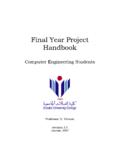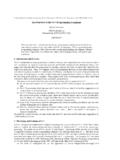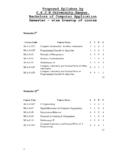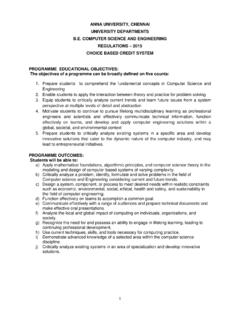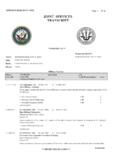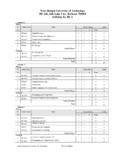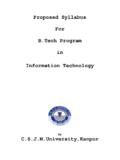Transcription of Basic Principles of Computer Programming in C - David …
1 1 Intensive Revision: Basic Principles of Computer Programming in CDavid Computer ModelInformation ProcessingqWhen we process information, we do one of two things: we change its representation (typically to enhance it) we analyze it to extract its meaningqHow do we process information?3 The Computer ModelComputer SoftwareqA Computer program is a sequence of instructions (statements)qExpressed in a given language ( C)qThe language has a vocabulary a set of wordsqThe language has a grammar a set of rules about how words can be linked together This is called the syntaxof the language4A C Program/* Example 1 *//* This is a C program to ask you to type a letter *//* and then to tell you what you typed */#include < >main() {char letter;printf( Please type a letter & then press Return >> );scanf( %c , printf( You typed the letter %c , letter).)}
2 }5A C Program/* Example 1 *//* This is a C program to ask you to type a letter *//* and then to tell you what you typed */ These are called comments They don t do anything, in that they don t cause the Computer to process information Their purpose is simple to annotated the program: to tell someone reading the program what the program does6A C Programmain() { mainis the name of the program; all C programs must have a mainpart. The open bracket ( and close bracket ) with nothing in between says that the program main doesn t work directly on informationqwe ll see later that we can put something in between the brackets and the program can use this something , typically to tell it what to do or to tell it what to C Programmain()
3 { Finally, there is the { characterqWe call this an opening brace or curly bracketqThis simply says that everything that follows until we meet the } character is part of the main programqThe } is at the end of the program and we call it a closing brace or curly bracket8A C Program#include < > says use the standard input/output utilities if you want to read and write messages There is a more technical interpretation of #include but we don t need to bother with this for now9A C Programchar letter; causes the creation of a variable which can represent characters The name of the variable is letter and it can be used to represent the letter a or b or c or j or v or z Think of it as a general purpose letter holder (for one letter only)10A C Programprintf( Please type a letter & then press Return >> ); This simply says print everything enclosed in the double quotes to the screen11A C Programscanf( %c , is, in a way, the opposite of the printfline Instead of printing things, it reads things In this case, we are reading in a character qthat s what the %c denotes qthere are other symbols if we are reading other things such as numbers12A C Programscanf( %c , Where do we put that character?))
4 We put it in the variable letter The symbol &is used to tell Computer that we are allowing the value of letter to be changed, to be given (assigned) the value we read from the keyboard. 13A C Programscanf( %c , If we didn t have the &symbol, then we wouldn t be able to change the value of letter to the character we C Programprintf( You typed the letter %c , letter); What s different here is qthe inclusion of the %c at the end of the message andqthe addition of the name of our character variable, separated by a commaqThe %c denotes a character and says we want to write out a character What character? The character which is held in the variable letter15A C Program Each line of this program above is known as a statement Did you spot the semi-colons, ; characters, in all of the above?)
5 QIn the C Programming language, the semi-colons are used to temininateor finish-off each distinct statement16 Summary/* This is a comment */main()is the name of our program#include < >means use the standard input and output factilities defined in the file a character variableprintf()prints a message to the screenscanf()reads something from the keyboard&says you can change the value of what follows%csays this is a character format; terminates a statement18 Summary The program does something like this:Ask the user to type in a characterRead the characterPrint out a message and the character we just read This is called pseudo-codeqit isn t a real piece of Computer code qbut it tells us in Computer -like way what the Computer code would do. 19 SummaryqLater on we ll use pseudo-code to describe what a progamdoes beforewe actually write the Computer programqThis preliminary draft of the program is called design qIt is a crucial part of the overall process of writing Computer software20 The Computer Model Assuming we have designed and written a C program, we now we want to run it Let s do that together21A Second Example ProgramIn this section we will develop another slightly more complicated program22A Second Example Let s say we want the program to compare two numbers and tell us if they are the sameqa simple task but all decisions basically come down to comparing two values This time, rather than start with the finished program.
6 We ll take one step back and figure out for ourselves what it should look like We ll do this using the pseudo-code we met above23A Second ExampleAsk the user to type in the first numberRead the first numberAsk the user to type in the second numberRead the second numberCompare the two number and print out a number This is fine but the last line is a bit too general To formulate exactly what we mean, let s try an example24A Second Example Let s say the first number is 10 and the second number is 12 How do we compare them? qsee if they are the same number. qHow can we say that? qWe could ask are they equal. qIn C the way we check to see if things are equal is to say something like:if one_thing== another_thing25A Second Example In the number system, 10 comes before 12 How might we formulate that?
7 We simply say:if one_thing< another_thing Similarly, we might ask:if one_thing> another_thing26A Second Example That s progress but we need more What are we going to doif one thing is equal to another (or if one thing is less than another) Again, it s fairly straightforward. You just say then do something27A Second Example And what if the answer to our question wasn t correct (or true)?qWe have two options: do nothing or do something elseif one_thing< another_thingthen do one thingelse do a different thing28A Second Example We normally write this as follows:if one_thing< another_thingthen do one thingelse do a different thing This indentationdoesn t matter to the Computer but it s very important readability by humans, especially as the programs become large29A Second Example This is called an if-then-else construct It can be stated more formally.
8 If the following condition is TRUE then do one thing else ( otherwise) do a different thing Note that if we didn t want to do anything at all if the test was not TRUE (that is, if it was FALSE) we d just leave out the else part (often called the else-clause)30A Second ExampleNow we can expand the Compare statement:ask the user to type in the first numberread the first numberask the user to type in the second numberread the second numberif the first number == the second number thenprint: the numbers are identicalelseprint: the numbers are different31/* Example 2 *//* This is a C program to ask you to enter two *//* numbers; it then compares them and prints a *//* message to say whether they are equal or not */#include < > main() {intfirst_number, second_number;printf( Type a number and then press Enter >> );scanf( %d ,&first_number);printf( Type another number and then press Enter >> );scanf( %d ,&second_number);32/* Example 2 *//* This is a C program to ask you to enter two *//* numbers; it then compares them and prints a *//* message to say whether they are equal or not */#include < > void main() {.}}
9 TEXT (first_number== second_number) printf( The two numbers %d are identical , first_number);elseprintf( The two numbers %d and %d are different , first_number, second_number);}33A Second ExampleSeveral things to note: We now have two integer variables (first_number, second_number) We declared them in the same way as before but we separated them with a comma. int first_number, second_number;34A Second Example We could also have saidintfirst_number;intsecond_number; Note that we put an underscore instead of a space. As a general rule, you can t have spaces in the middle of the name of a variable. 35A Second Example We changed the names of the variables in the scanfstatements to first_numberand second_number Note that we put a pair of brackets around the test in the ifstatement; these brackets MUST be thereif (first_number == second_number)36A Second Example In the second printfstatement, we now have two variables: first_numberand second_numberprintf( The two numbers %d and %d are different , first_number, second_number); These are separated by a comma Because we have a second variable, the value of which is to be printed out in the message, we also need a second %d Note that the value of the number will go into the message exactly where each %d is placed37A Second Example Finally, did you notice that we left out the word thenin the C program?
10 In C, the thenis omitted Since it is normally required in many other Programming languages and since it sounds more natural anyway, we ll keep on using it in our pseudo-code and then simply drop it when we write the corresponding C program Now, let s enter and run the program38 Example No. 3 Learn a little more C Begin to learn how to solve problems qsoftware development is more about solving problems that it is about writing code qAs we become more proficient at software development, we begin to take the underlying skills (or writing code) for granted39 Example No. 3 Compute the Scrabble value of a collection of 7 lettersScrabble a word-game players are awarded points for creating words from a random sample of seven letters Each letter carries a different point value the value of the word is the sum of the point values of each letter in the word We will assume we have a word with 7 letters.

